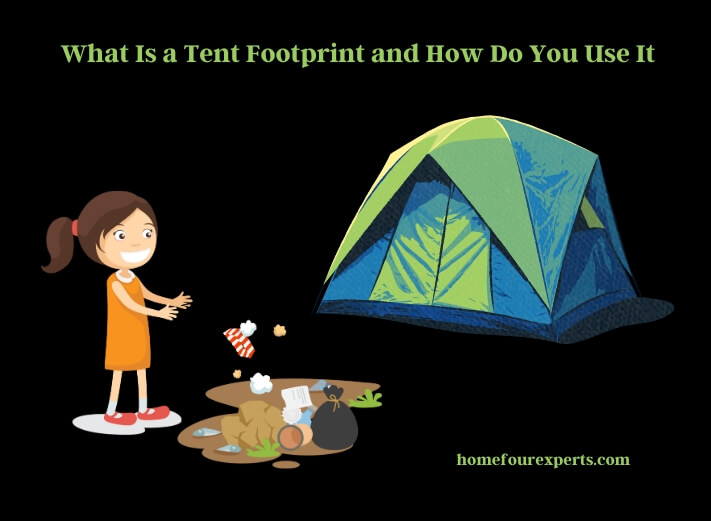Published on: March 23, 2022
Written by Camila Avery / Fact-checked by David Rowan
Are you new to camping? Does the word ‘tent footprint’ confuses you? Tent footprint, groundsheet, and ground terp are all synonyms of the same product. Camping can be positively or negatively memorable for just the appropriateness of its footprint.

Let’s not confuse you about it anymore and talk about this essential of a tent which is called ‘tent footprint’.
What is a Tent Footprint?
A tent footprint is a plastic sheet that is placed underneath the tent as a protective measure. This waterproof layer protects the tent from absorbing moisture, scratches, tear, and wear and from rain also.
There are many ways of making a tent footprint at home, in an inexpensive way. Also, some tents come with their own tent footprint. In this article, you will know everything you need to know about tent footprint.
Why Should You Use it?
Before discussing how to use a tent footprint, let’s talk about why you should use it? Is it really that necessary? What if you chose to start camping without this? The advantages of using a tent footprint are listed here. It should convince you to use it for the next trip.
Saves from Moisture Buildup
If you put a piece of tissue paper on wet soil, it soaks up moisture. We don’t want it to happen to our camping tent. No matter how good the quality of the tent is, the temperature differences between the inside of the tent and the ground underneath cause condensation.
The footprint underneath the tent will be the first thing to come in contact with the ground. So, if it causes condensation or sips moisture from the soil, the footprint will catch it, not the tent.
Better Insulation
Insulation is a technique that slows down temperature fluctuation. For example thermos or hot bags. Nowadays all the tents in the market are sold as insulated tents. It doesn’t mean that you won’t feel the weather of the outside air while sitting in the tent. Rather, the interior of the tent will slow down heat transfer.
However, when you use the groundsheet underneath the tent base, you will instantly feel the difference. The sheet creates an additional layer to make the insulation even better.
Prevents Rain Water Seeping
If placed properly, the groundsheet or footprint will save you, your tent, and the gears inside from soaking in water. The rainwater will run off from the tent body and catch underneath the ground. Again, the footprint will work as a floating tire to keep the tent floor out of the rainwater.
Prevents Early Wear of Tent Base
The rough surface of the campsite, mountain, or forest is not so friendly towards thin tent material. The tent floor usually is the most durable part of a tent. But it can wear and tear due to inappropriate maintenance and misuse.
The roots of the tree, spiky rocks, sand, and twigs or thorns from the tree are potential troublemakers for the tent base. If one of those remains underneath and someone steps on it, it will hurt and the tent may tear off. So, it’s better late than never. Use a groundsheet or tent footprint to make things last for longer.
Prepare the Site
When it comes to camping, you can’t always expect normal things to happen. It is bitterly true while we search for a decent campsite. Most of the time the site we found is not even flat enough, not clean enough, or not big enough. The footprint will help to minimize the problems in these situations. It kind of preps up the site to set the tent and start camp.
DIY Tent Footprint
Store-bought tent footprints are expensive. Likewise, the tents that come with footprints are also expensive. The smartest way is to buy a tent alone and use it with a DIY tent footprint. To make this, you literally don’t have to do anything other than buy a plastic sheet from the store.
First, measure the tent base. The measurement is usually printed on the package of tent. You can have it from there or measure the length and width of the base using a measuring tape.
Now, go to the local hardware store. Several materials can be used as ground tarps or tent footprints. You must have seen the painter’s tarp. It is also known as Polycro. It is the most available one. Secondly, a thick polythene sheet is also a great alternative.
The kind that is used in construction sites to protect the under-construction building is useful. Those are also known as Tyvek. Or you can use shrink plastic that you use to cover windows during snowfall.
One should buy the ground terp based on their camping preferences. Some people camp with family and some love solo backpacking. You can still use a footprint while backpacking. For backpacking, just choose the lightest plastic sheet which can be folded into a matchbox and weighs only a few grams.
Family or big gatherings will create bigger movement inside the tent. So, one should choose a thickened and heavier material to use as a footprint.
The footprint has to be larger than the tent base. It should be 1 ft larger all around. Now your tent footprint is ready. It won’t cost more than 3 bucks whereas store-bought tent footprints can cost up to 50 bucks.
How to Set Up?
If your tent already has one footprint with other attachments, then there will be instructions to set up the footprint. Usually, it comes with belts and buckles to set it with the tent stakes and spread it underneath the tent. Compared to plastic DIY plastic-made footprints, these look smarter and do not make a plasticky sound when people move inside the tent.
But the problem with those footprints is, they might catch up with the rain drippings from the tent wall and make a pool of water underneath the tent. It is an irony that it was placed to protect the tent from the water pool, right?
- The DIY tent footprint is a lot better than that. You just spread it on the selected site. Then set the tent on it as you usually do. Now fold the ground tarp or tent footprint toward the ground to make it smaller than the tent base.
- The logic for doing this is, if the groundsheet is smaller then it will not come in contact with the rain drippings from the tent wall when it rains. So, you must make sure that the footprint hides underneath the tent base.
- For another protective measure, you can use another piece of plastic sheet inside the tent. This one also should be as big as the groundsheet. While placing it inside the tent, you should make a tub with it. So that if it rains heavily and water rises up, or the stitching of the tent loses its water-resistant capability, then the plastic tub will keep you dry.
- Another scenario is if you are camping in a desert or mountain, or somewhere it doesn’t rain that time, then there is no need to fold it downward. So that you will have a ‘porch all around the tent where you can put off your shoes or place your gear safely.
FAQs
Does a Tent Footprint go Inside or Outside?
A tent footprint must go outside, under the tent. It is used to protect the tent from abrasion and moisture. However, people also chose to use the footprint that comes with their tent inside the tent and use a DIY groundsheet under the tent base. Both are used for better cushioning and to protect the tent and its gears inside from the rain.
Are There Any Benefits to Using a Tent Footprint Instead of Simply Pitching a Tent on the Ground?
Yes, there are several benefits to using a tent footprint instead of pitching a tent directly on the ground. A tent footprint can help protect the bottom of your tent from abrasion and wear, as well as provide an extra layer of waterproofing. It can also help to keep the tent floor clean, as dirt and debris will not be able to accumulate as easily. Additionally, a tent footprint can help insulate the tent from the cold ground, making the tent more comfortable for camping in cold weather.
How Should a Tent Footprint Fit?
A tent’s footprint has to be smaller than the base. Whether you buy it this way or use a large tarp and ford it downward to make it smaller. If the footprint is the same as the base, then it will act as a funnel and catch rain drippings and make a water pool underneath the tent.
Please note the footprint size only matters when it rains. Otherwise, you can use a larger sheet or footprint and use it unfolded to have better coverage under the tent.
Which Side of the Tent Footprint Goes Down?
If it is a DIY footprint, then there is no particular side to face upward or downward. But store-bought footprints come with different textures on different sides. The shiny side would face upward and the matt side should face the ground. The shiny side has water-repellent properties to prevent moisture from seeping through it.
Which one is Better? DIY Footprint or Tent-Specified?
Obviously, the DIY tent footprints are better. Those are cheap, fail-proof, can be customized easily for different locations of seasons, and can be replaced easily.
On the other hand, the store-bought footprints are high quality, but expensive too. Those usually do not protect much from rainwater. It is more of a protection for the tents from forming scratches and early wearing out.
Concluding Remarks
I hope after reading all the facts we have discussed about ‘tent footprint’ here, you will be successfully able to make and use one all by yourself. Please be concerned about sharing this knowledge so that your friends also can get the benefit of a properly used tent footprint.
Before packing camping goods, when you run a ‘rain check’ on the tent, please do the same to the footprint as well. So that you can be sure that there is no crack in it, it is still good to use and serve the purpose.
Read more:
About This Writer

Guys, I am Camila Avery and I love to help my mom to do indoor & outdoor activities. As a lady, I have passed my time on gardening, home improvement, and personal or self-care. I have acquired some degrees in outdoor recreation, beauty, and hair care. It is not easy to work with top-level professional beauty experts. But, I got that opportunity and experimented with different hair extensions, hair colors, and cuts.